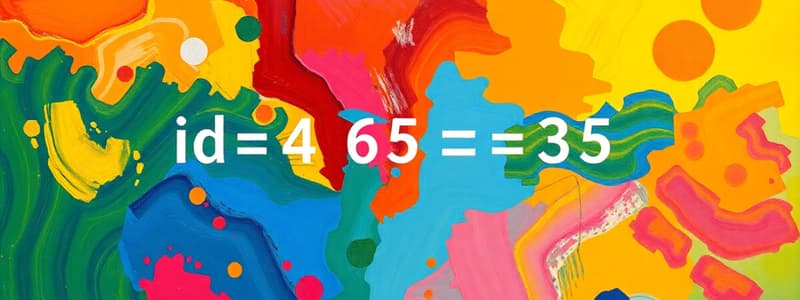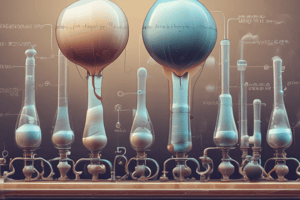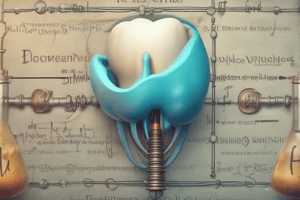Podcast
Questions and Answers
According to Boyle's Law, what happens to the pressure of a gas if its volume is doubled while the temperature remains constant?
According to Boyle's Law, what happens to the pressure of a gas if its volume is doubled while the temperature remains constant?
- The pressure quadruples.
- The pressure is halved. (correct)
- The pressure remains the same.
- The pressure is doubled.
In real gases, the inverse relationship between pressure and volume always holds true, regardless of temperature or pressure.
In real gases, the inverse relationship between pressure and volume always holds true, regardless of temperature or pressure.
False (B)
What two conditions commonly cause a gas to deviate from ideal gas behavior?
What two conditions commonly cause a gas to deviate from ideal gas behavior?
Low temperature and high pressure
The SI unit of pressure is the _______, which is equal to 1 N m-2.
The SI unit of pressure is the _______, which is equal to 1 N m-2.
Imagine a container of gas where the intermolecular forces are extraordinarily strong, and the volume of the molecules themselves constitutes a substantial portion of the container's volume. If you were to double the pressure on this gas, what would you expect to happen to the volume, compared to an ideal gas under the same conditions?
Imagine a container of gas where the intermolecular forces are extraordinarily strong, and the volume of the molecules themselves constitutes a substantial portion of the container's volume. If you were to double the pressure on this gas, what would you expect to happen to the volume, compared to an ideal gas under the same conditions?
Which of the following is NOT an assumption of the ideal gas model?
Which of the following is NOT an assumption of the ideal gas model?
Real gases always perfectly adhere to the ideal gas model, regardless of temperature or pressure.
Real gases always perfectly adhere to the ideal gas model, regardless of temperature or pressure.
According to the ideal gas model, what type of collisions occur molecules?
According to the ideal gas model, what type of collisions occur molecules?
In an ideal gas, the intermolecular forces between gas particles are considered to be ______.
In an ideal gas, the intermolecular forces between gas particles are considered to be ______.
What happens to the molar volume of an ideal gas at a specific temperature and pressure?
What happens to the molar volume of an ideal gas at a specific temperature and pressure?
Consider two identical containers, one filled with an ideal gas and the other with a real gas, both at the same temperature and pressure. Which gas is likely to exert a lower pressure if the volume is slightly decreased, assuming all other variables remain constant?
Consider two identical containers, one filled with an ideal gas and the other with a real gas, both at the same temperature and pressure. Which gas is likely to exert a lower pressure if the volume is slightly decreased, assuming all other variables remain constant?
If the Kelvin temperature of an ideal gas doubles, the average kinetic energy of its molecules also doubles.
If the Kelvin temperature of an ideal gas doubles, the average kinetic energy of its molecules also doubles.
Imagine a scenario where a gas is compressed to an extremely small volume and cooled to near absolute zero. Which of the following behaviors would this gas most likely exhibit, defying the assumptions of the ideal gas model?
Imagine a scenario where a gas is compressed to an extremely small volume and cooled to near absolute zero. Which of the following behaviors would this gas most likely exhibit, defying the assumptions of the ideal gas model?
Flashcards
Boyle's Law
Boyle's Law
At constant temperature, the pressure of a gas is inversely proportional to its volume.
Gas Pressure
Gas Pressure
Gas molecules constantly strike container walls, creating measurable pressure.
Pressure Units
Pressure Units
Pascal (Pa), atmosphere (atm), millimeters of mercury (mm Hg), bar, and pounds per square inch (psi).
STP for Gases
STP for Gases
Signup and view all the flashcards
Real Gas Deviation
Real Gas Deviation
Signup and view all the flashcards
Ideal Gas
Ideal Gas
Signup and view all the flashcards
Molecular Motion
Molecular Motion
Signup and view all the flashcards
Elastic Collisions
Elastic Collisions
Signup and view all the flashcards
Intermolecular Forces
Intermolecular Forces
Signup and view all the flashcards
Real vs. Ideal Gases
Real vs. Ideal Gases
Signup and view all the flashcards
Kinetic Energy & Temperature
Kinetic Energy & Temperature
Signup and view all the flashcards
Gas Volume
Gas Volume
Signup and view all the flashcards
Molar Volume
Molar Volume
Signup and view all the flashcards
Study Notes
- Ideal Gas SL S1.5 Study Notes
Learning Outcomes
- An ideal gas comprises constantly moving particles with negligible volume and no intermolecular forces; collisions between particles are elastic.
- There is a need to recognize the assumptions in the ideal gas model.
- Real gases deviate from the ideal gas model, specifically at high pressure and/or low temperatures.
- The limits of the ideal gas model should be explained.
- The molar volume of an ideal gas is constant at a specific temperature and pressure.
- Investigate the relation between temperature, pressure, and volume for a fixed mass of an ideal gas, and analyze graphs showing these variables.
- The relationship between pressure, volume, amount, and temperature of an ideal gas is shown in the ideal gas equation PV = nRT and the combined gas law.
- Solve ideal gas equation problems.
Overview
- The ideal gas model assumes that gas particles do not attract or repel each other and occupy negligible volume. Additionally, it presumes that collisions between gas particles are perfectly elastic, meaning that there is no loss of kinetic energy during these collisions. This model is useful for simplifying calculations and understanding gas behavior, especially at low pressures and high temperatures where real gases behave more like ideal gases.
- Compare real gases vs. ideal gases
- The molar volume of an ideal gas
- Pressure, volume, amount, and temperature relation for an ideal gas
Assumptions of the Ideal Gas Model
- Gas molecules are in constant, random motion, moving in straight lines until colliding with another molecule or the container's side.
- These collisions are perfectly elastic; therefore, no energy is lost from the system.
- There are no intermolecular forces between gas particles.
- Due to absent intermolecular forces, an ideal gas will not condense.
- The kinetic energy of molecules is proportional to Kelvin temperature.
- Gas molecules' volume is insignificant compared to the container's volume they occupy.
- Vaporized water occupies 1600 times the volume of liquid water at standard temperature and pressure (STP), 273.15 K and 100 kPa, which equals >99.9% empty space so gas molecules can move freely.
- An ideal gas consists of elastically colliding particles, no intermolecular forces, and negligible volume compared to the gas' volume.
Pressure-Volume Relationships
- Boyle's Law: at constant temperature, the pressure of a gas is inversely proportional to its volume, expressed as p ∝ 1/V.
- Boyle's Law can also be expressed as pV = k (a constant) or P₁V₁=P₂V₂
- Gas molecules constantly strike and bounce off container walls to create measurable pressure.
- When volume is halved, pressure doubles.
- Graphs show an inverse relationship between pressure and volume.
- The SI unit of pressure is Pascal (Pa), where 1 Pa = 1 N m⁻² = 1 J m⁻³.
- Other pressure units include atmosphere (atm), millimeters of mercury (mm Hg), bar, and pounds per square inch (psi).
- Standard Temperature and Pressure (STP) for gases is 273.15 K and 100 kPa.
Worked Example Using Boyle's Law
- A weather balloon with 32.0 dm³ helium at 100.0 kPa pressure reaches 4500 m altitude, where the pressure is 57.7 kPa.
- To calculate the volume at that altitude, it's assumed that the amount of helium and temperature remain constant.
- According to Boyle's Law: V₂ = (V₁ × P₁) / P₂
- Using the values = ( 32.0 dm³ × 100 kPa)/ 57.7 kPa ≈ 55.5 dm³
Real Gases vs. Ideal Gases
- A gas deviates from ideal behavior when detectable intermolecular forces exist and/or a significant gas volume is occupied by the molecules.
- Gases commonly deviate at low temperature and/or high pressure.
- At low temperature, lower kinetic energy reduces the elastic rebound of gas molecules as intermolecular forces of attraction form.
- At high pressure, the volume of molecules is a significant portion of the total volume, and molecules are not compressible.
- Ideal gas conditions include low pressure and high temperature.
- At low pressure, space occupied by molecules is negligible due to very few unit volume molecules within the container.
- At high temperature, high kinetic energy prevents intermolecular attraction between gas particles.
The Molar Volume of an Ideal Gas
- Same volume of any two gases at the same temperature and pressure has an equal number of particles.
- The molar volume of an ideal gas, Vm, at STP, equals 22.7 dm³ mol⁻¹.
Worked Example
- With a 2.47 g mass, a 2.00 dm³ unknown gas has a molar mass of 28.0 g mol-1 at STP.
- n = V/Vm = (2.00 dm³)/(22.7 dm³ mol⁻¹) = 0.0881 mol
- M = m/n = (2.47 g) / (0.0881 mol) = 28.0 g mol⁻¹
Combined Gas Law
- Pressure is inversely proportional to volume and directly proportional to absolute temperature: p ∝ 1/V; p ∝ T
- The combined relationships can be shown as: p ∝ T/V
- (pV)/T =k (a constant) or (P₁V₁) / T₁= (P₂V₂)/ T₂
- This formula is known as the combined gas law.
Ideal Gas Equation
- pV = nRT
- R is known as universal gas constant, and it equals 8.31 J K⁻¹ mol⁻¹
- p is pressure in Pascals (Pa)
- V is volume in cubic meters (m³)
- T is temperature in Kelvin (K)
- n is the amount in moles (mol)
Studying That Suits You
Use AI to generate personalized quizzes and flashcards to suit your learning preferences.




